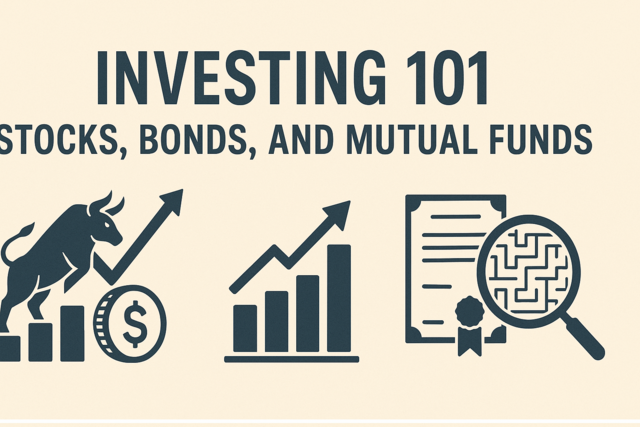So the very first thing to understand as we journey into preparing for (and then enjoying!) retirement is that while everything changes, life goes on. Bills have to be paid. Investment decisions have to be made. Wives and husbands have to be placated. Grandchildren have to be played with. Illnesses have to be suffered. You simply now get to do all of these things full-time instead of working full-time. It all has both positive aspects and negative ones.
Some people start planning for retirement very early in their careers, investing and saving all their adult lives. Others may wake up at age 60 and think "Maybe I should consider what I intend to be doing five years from now." It's never too late or too early to start planning for retirement; your personal situation will determine when and how you get to live out your retired life, whether you started early or came to the party late. The most important part of handling where you're starting out is being very honest about it. Recognize the challenges you have, the changes you need to make (if any), and how you're going to get where you want to be to retire the way you want.
As we journey through the world of retirement, it is important to understand how the term 'retirement' will be used in this article. In the past, we have often thought of retirement in black and white terms: you work your job, save up money, then retire from your job and don't work at all anymore. There are numerous ways that retirement has changed and not everyone wants (or can afford to) stop working entirely. As modern technology is changing the way we work, it also is changing the outlook for some individuals who may want options outside of this traditional retirement definition. Programs for seniors to be included in the workforce also offer opportunities to individuals who want to work as well; sometimes less physically demanding or more cerebral positions can be found, making it easier to work a job later in life. Whether you continue some kind of work or not, this article will assume that your retirement is not dependent upon working; i.e. information is based on the assumption that you won't work after retirement, but if you want to do it, this information will still apply.
While planning for retirement, sacrifices have to be made. Whether it means living on a stricter budget, working longer than you want, or even just having to put up with a terrible boss, it is absolutely normal to be irritated or frustrated with the sacrifices involved. By no means is it recommended to stay in a miserable job; make the best decisions for you. But understand that somewhere along the way sacrifices will have to be made. Oftentimes, this is when most people begin to think about how luxurious retirement will be because they will be done with their boring work, mean boss, bratty coworkers and more. The problem with this thought process is that it's based on negative emotions, so even the allure of retirement is built on unpleasant thoughts and feelings. These thoughts often occur along with feelings of hopelessness about retirement and the parts of life that won't go away then � all those responsibilities we mentioned earlier.
This thought process may get you to retirement on a schedule you like, but it will most likely not get you there in a peaceful, positive state of mind. And after all, what good is 20 years of retired life if the 40 years of adult life preceding it is miserable?
Instead, think of all of the upsides of a retirement from work but not from life: freedom to read more, learn more, and explore new hobbies. Consider having more time to travel, to visit family and friends, and to try new adventures. During our pre-retirement lives, we work at least forty hours a week and then spend the remainder of our waking hours usually attending to other responsibilities like children, chores, and household management. Caring for sick family members, fighting disease, and being a single parent are additional challenges so many of us face. By the time we get to retirement, it's certainly no wonder that rest and sleep are huge parts of the fantasy. But it's all of those things we bemoan not having time to do during adulthood that can be our best inspiration. Whether it's school, art, sports, travel, or even trying stand-up comedy, there are endless possibilities to explore once you have the time and freedom of retirement.
If you build your rock of retirement on the lure of these activities you want to pursue, the sacrifices won't seem so large or harsh; 'sacrifice' has simply become 'choice'. You also will have planned and prepared for your retirement on positive thoughts and feelings, helping yourself live a happier pre-retirement life as well as better appreciating your retirement when it comes.
Milestones can be a tremendously effective tool to help us assess where we are on the road to retirement and where we need to be. Consider the following common milestones many of us anticipate or live in our whole lives:
Not everyone experiences all of these milestones yet are able to still have fulfilling lives; in that way, it is helpful to remember that there are also many "correct" ways to retire. In general, however, these milestones still give us a basic roadmap for living a full life.
-
Start a regular savings account.
-
Start your retirement savings.
� Starting at age 45 - $71,880
� Starting at age 35 - $206,440
� Starting at age 25 - $555,454
So although you only saved $12,000 in each set of 10 years, those 10 years turn that $12,000 into some serious money.
� Diversify your interests.
We will cover saving and investing for retirement more in the next chapter, but it is quite important to diversify your interests early. Like in most of life, you don't want all your eggs in one basket, even if that basket seems to be made of steel. Broadening your investments will help ensure you get where you want to go by retirement time.
� Increase your amounts contributed.
Most retirement savings plans set maximum percentage amounts you can contribute. However, at age 50, you can boost your savings while trying to "catch up" by increasing how much you put in.
� Avoid withdrawal penalties.
When you hit age 55, you are now able to withdraw your money from an employer's retirement fund if you have separated from their service. By age 59 �, you can now withdraw from your traditional IRA or retirement savings account without any penalties. At age 70 �, you must begin withdrawing minimum distributions from your traditional IRA.
� Start drawing social security.
At the age of 62, you can begin receiving social security benefits at a reduced rate of 25%. Between ages 65 and 67 (depending on what year you were born), you may begin receiving your regular social security benefits. By the age of 70, your social security benefits have reached their maximum so (unless you just love to work), retire!
Saving money aside, there are other milestones to hit on the way to retirement as well. Some allow for more financial freedom during pre-retirement while others are all about planning to enjoy your retirement. Consider the following:
� Paying off cars
� Paying off your home
� Paying off student loans
� Purchasing a second home or making arrangements for living after retirement.
� Preparing to return to school.
� Planning a long or experience-rich trip or vacation.
� Looking into new hobbies or exploring new ideas.
Enjoy planning for retirement and celebrate all of the milestones along the way, no matter when you hit them. You shouldn't worry if your milestones are different than these; as long as they guide you safely to your retirement, you know what works best for you!
Investing and Saving for Retirement (Part 1)
401(k) A defined contribution plan (see below) wherein an employee can contribute to the plan from their paycheck. In some cases, the employer may also make contributions.
401(b) TSA Plan A retirement plan offered by some tax-exempt organizations as well as public schools, these are Tax-Sheltered Annuity Plans. Most often these plans are funded through elective deferrals and non-elective employer contributions.
Actual Deferral Percentage Also called ADP, this is an annual test of a 401(k) plan that compares the average salary deferrals from highly and non-highly compensated employees.
Annual Additions The annual total of all employer contributions, employee contributions, and forfeitures allocated
Annuity A contract between an insurance company and a person or business wherein the insurance company agrees to make regular payment to someone for a fixed period or for life
Balanced Fund A financial fund that invests in debt instruments (like bonds) and equities (stocks) to reduce risk by diversifying through investing in different markets
Balanced Portfolio Like a balanced fund, a balanced portfolio is a mixture of investments, some of which are more conservative and some of which are riskier
Bond Fund A financial fund with primarily corporate, government, and/or municipal bonds
Cash Balance Plan A defined benefit plan (see below) wherein the benefit amount is computed based on a formula and is more likely to make lump sum distributions.
Compound Interest The interest that is credited on both previously credited interest as well as on principal. Such interest is credited daily, monthly, quarterly, semiannually, or annually.
Contribution Payment made to an annuity or retirement plan
Death Benefit The amount paid to a beneficiary upon the death of the insured. May also be called a survivor's benefit.
Deferred Compensation A financial arrangement wherein part of the income of an employee is deferred to a future time to avoid taxation in the current year
Delayed Vesting An arrangement where an employee must complete a specific period of service before being entitled to retirement benefits.
Diversification An act of distributing assets to different investments to reduce risk
Elective Deferrals Contributions to a plan by the employer at the employee's election and are excludable from the employee's gross income
ERISA The Employee Retirement Income Security Act of 1974, ERISA is a federal law that has established standards of protection for people in most private-sector retirement plans; plans must provide participants with plan information, set minimum standards, and more
ESOP An Employee Stock Ownership Plan is a defined contribution plan that is mostly (if not exclusively) in employer stock
Fixed Annuity Frequently used by retirement accounts, this is a traditional insurance investment arrangement that guarantees principal and a specified interest rate. Fixed annuities may also offer dividends.
Forfeiture The amount of an employee's account balance that is lost when the employee terminates employment
Global Fund A fund with investments that are worldwide or international
HCE A Highly Compensated Employee (HCE) is an individual that received compensation (in the preceding year) from the business of more than $110,000 or who owned more than 5% of the interest in the business
Index Fund A fund that contains securities or equities than hold a similar percentage position of individual securities as a particular broad market
Interest The cost of borrowing, usually expressed as a percentage of the amount borrowed; this can also be the return earned on an investment
Investment The purchase of bonds, stocks, options, mutual funds, and more with the goal of future income or capital gains
Lump-Sum Distribution A payment of the entire value of an investment
Minimum Distribution An amount that must be paid from most tax-favored retirement plans in accordance with federal law
Money Purchase Plan A financial plan that requires designated annual contributions from an employer to individual accounts
Mutual Fund An open-ended fund that an investment company operates where they pool money from individuals to meet specific criteria and goals
Participant Any eligible employee who participates in or is covered by a retirement plan
Plan Administrator The person who has responsibility for running the retirement investment plan and may be the employer, a committee of employees, or someone hired for this purpose
Plan Document A written document (which must be provided to the employee) that determines the administration of the retirement investment plan
Plan Fiduciary Anyone who uses discretionary control or authority over management or administration of the plan
Plan Trustee An individual with the exclusive authority and discretion to control the assets of the retirement investment plan
Portfolio The combination of investments and securities held by a mutual fund or an investor
Principal The original value of a debt or an investment
Profit-Sharing Plan A defined contribution plan wherein the employer may determine or the plan may provide how much will be contributed to the plan out of investments, profits, or otherwise. This may include a 401(k) plan.
Rollover The transfer of an employee's retirement funds from one plan to another without incurring a tax liability
Safe Harbor 401(k) Similar to a traditional 401(k) but the employer must make contributions for each employee but will then endure lighter administrative burdens
Salary Reduction Contributions that are not subject to most income taxes and are kept from a person's salary under an agreement
Securities Issued by government bodies or corporations, securities are investment instruments that offer investors a creditor relationship or shares of ownership
Socially Responsible Fund An investment fund that makes investments which are committed to promoting social, moral or political issues
Summary Plan Description Provided by the plan administrator, this document includes a plain-language description of the important aspects of the plan
TDA A tax-deferred annuity that is available to certain groups wherein part of the employee's income is excluded from taxation and invested.
Years of Service How long an individual has worked in a position covered by the plan
The best time to begin saving for retirement, as previously outlined, is early � as early as possible, in fact. Thankfully, there are easy ways to get started. For most people, our 20s are our "exploratory" time in terms of job and career. This is also when some people get married or even start having children. In fact, more and more people aren't graduating from college until their mid-20s and then there are still those who go on graduate school. For people that don't marry and/or have children until their late 20s or 30s (or later) the age at which it seems convenient to start investing for retirement gets older and older. Unfortunately, this has financial ramifications for your retirement schedule, so it's important to begin making these changes as early as possible, even if you can only start off saving a small amount.
Upon starting a post-college or long-term job, be sure to talk with your Human Resources department (or person) in order to get some basic information about your employer's retirement options. Most often, they will offer a 401(k) or comparable plan , so the first thing you'll want to do is work up to whatever percentage your employer will match. Be aware that you may already have been automatically enrolled in their 401(k) plan. If you can sign up immediately for the full amount your company will match, do so. If not, a gradual approach is usually easy. Start with 1% or 2% or whatever you can afford, then try to increase by .5-1% every six months until you hit the match. After that, keep increasing your contribution to 1% or more per year until you are contributing about 15% or so including the match your employer will make. Eventually you will likely max out the contributions to your 401(k) (or similar).
If you and/or your spouse earns a salary on the lower end of the spectrum (under $27,750 for a single or $55,000 for a married couple), you can receive a tax credit for retirement savers. This credit is in addition to the common, upfront tax breaks for IRA and 401(k) contributions. If you're married, you may be able to contribute to a spousal IRA as well. You may be eligible if you file your taxes jointly and have a stay-at-home spouse.
At some point in your 40s or so, it's important to make sure that you have sat down and consulted with a financial planner. If you can do it earlier, great, but you don't want to wait until you're older unless your 40s have already lapsed. Part of this should include a financial checkup to make sure if you're on track or not for retirement. The advisor should then work with you to find ways to increase your savings or get you back on track.
Be aware that it is ideal that you're able to pay off any existing debts such as mortgage, credit card, student loans and more by the time you're 60. If you haven't done so, don't be discouraged. But if it is at all possible, do so in order to then free up cash prior to your retirement.
As you prepare closer and closer to retirement time, you will want to consider a few work-related issues to plan for. First, investigate your health care possibilities. If you retire prior to age 65, you'll need health coverage until you will be eligible for Medicare. You'll also most likely want to have supplemental coverage after Medicare kicks in. Look into private individual health care plans to find the best fit for you; because our bodies often require more care as we age, you will want to be sure that you are properly insured.
Lastly, remember to put off drawing social security until as late as possible in order to get your full benefits.































